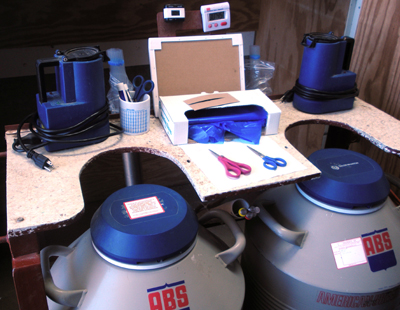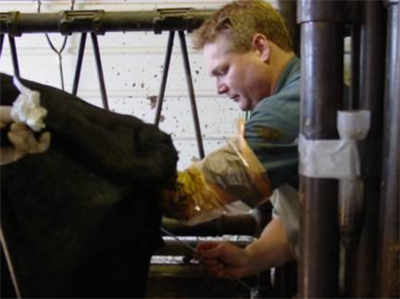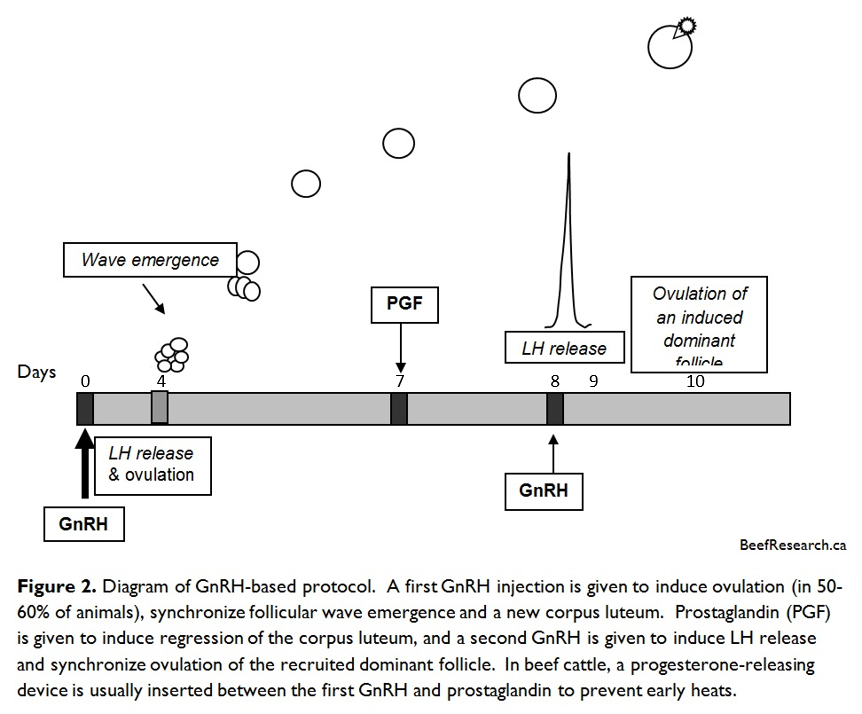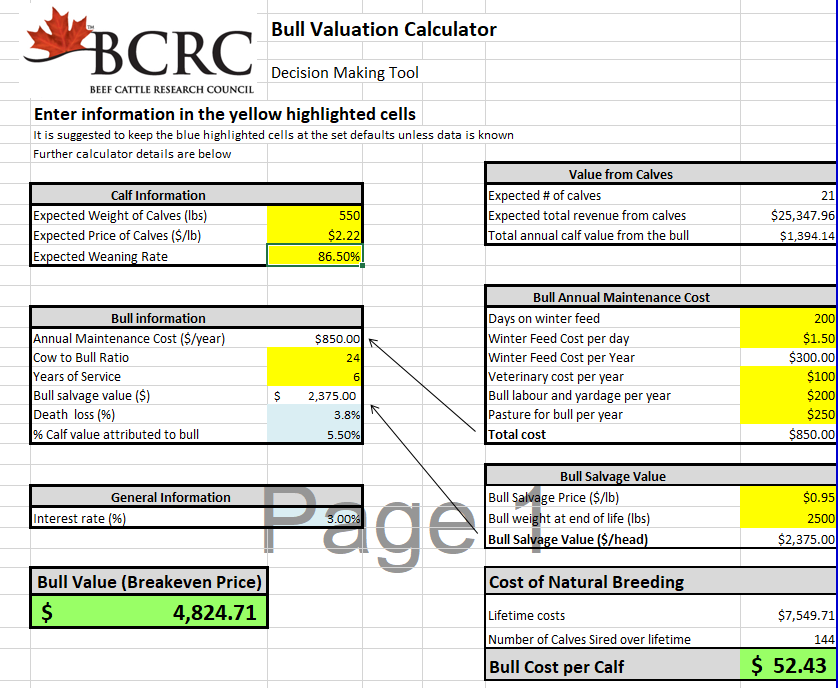Artificial Insemination
Although artificial insemination (AI) of cattle has been possible for 60 years, this technology has not been used widely in the Canadian beef industry. Genetic evaluation of beef bulls has improved considerably in recent years, making bull selection more objective and reliable. Sexed semen, expected progeny differences (EPDs) and the ability to select for specific traits identified through DNA markers are also now available, increasing the need for and use of AI. Considering the costs of natural service and lost genetic opportunities, AI can be profitable, even in commercial cattle.
On this page:
Key Points
|
Introduction
Pregnancy rates to AI can be similar to those with natural service, but insemination must be done at the correct time. Most AI programs require estrus (heat) detection and many use some method of estrus synchronization. Recent scientific studies have greatly increased our understanding of reproductive function in cattle and have improved our ability to regulate their reproductive cycles.
A common criticism of AI in beef cattle is that not all females will be become pregnant so clean-up bulls are always necessary. This is not entirely true; resynchronization protocols have been developed leading to management schemes exclusively for fixed-time AI, eliminating the need for clean-up bulls. In one study in Brazil, a cumulative pregnancy rate of 87.4% was achieved after three fixed-time inseminations in a 64-day breeding season. As an alternative, it is possible to greatly reduce the number of bulls needed, especially in large herds. For example, with 100 heifers and a 60% pregnancy rate to fixed-time AI, only 1 or 2 bulls is required to clean-up as opposed to at least four without synchronization and AI. Another criticism is that all calves will be born on the same day. This is not true; synchronized cattle normally calve over a period of 2 to 3 weeks.
Cost of Natural Service
The true costs of natural sire service are often underestimated. Factors including annual maintenance costs, interest and bull performance should all be considered. For example, a bull that is expected to wean 21 calves weight 550 lbs on average per year would be accountable for an estimated $1,394 per year. The annual maintenance cost for the bull including winter feed costs, vet bills, yardage and pasture is $850 per year. The salvage value of the bull is $2,375 and over its lifetime, the cost of maintaining the bull for six years is $7,549.71. If the bull successfully sires 144 calves over the 6 years the break even value or the price you should be willing to spend on the bull is $4,824.71 which results in a cost of $52.43 per calf. Since not all of the females will wean a calf, and many bulls may be lost or culled before six seasons of use, the real costs can easily exceed $60 per pregnancy.
Click the image to download the Excel file shown above and calculate the cost of a bull per naturally sired calf.
Economics of AI
Depending on the protocol employed, it is estimated that fixed-timed AI is likely to cost $20 to $30 per female. Semen costs are in addition to this with typical prices ranging from $10-$30 per insemination dose.
Calculation of the true cost of a synchronization program must include the costs of:
- consumables,
- hired labor (e.g., inseminator),
- additional time required for management,
- semen costs and
- a charge for animal handling (including weight loss and use of facilities).
On the revenue side of the balance sheet, consideration should be given to:
- the length of the calving season
- its effects on the provision of monitoring and assistance during calving,
- its effects on the uniformity of weaning weights (based on both sire and day of birth).

Appropriate AI sire selection can result in substantial reductions in dystocia (calving problems) in heifers, and consequently
less interventions, more calves weaned and improved postpartum (after calving) reproductive performance. Similarly, selection of sires with superior weaning weights, yearling weights, feedlot performance, and carcass characteristics can improve the profitability of a cow-calf operation. These advantages will be of greatest benefit to the cow-calf producer that either retains ownership of the cattle, or that is able to convince buyers to provide compensation commensurate with the cattle’s genetic potential.
With pasture breeding, it is difficult for a bull to sire more than 40 calves in a 6 to 8 week calving period. Through fixed-time AI, the number of females that can be bred to a single sire in a single day is virtually limitless. High-quality, highly sought after genetics may be purchased through a semen supplier enabling astute cattlemen to produce a more consistent group of cattle than ever before. As an alternative, a single bull of very high genetic merit can be purchased and used through fresh, extended semen in a fixed-time AI protocol, siring virtually limitless numbers of offspring.
Reproductive Function
The basic features of the reproductive cycle of cattle are well known. Although the estrous cycle averages 21 days, it ranges from 18 to 24 days. Ovulation (release of the egg from a follicle) occurs more than 24 hours after the beginning of standing estrus (heat). Following ovulation, a corpus luteum develops, secretes progesterone and prepares the uterus for pregnancy. If the cow is non-pregnant, prostaglandin is released from the uterus late in the cycle, causing destruction of the corpus luteum; progesterone levels decrease, estrogen production from a growing follicle increases and the cow goes back into heat.
Follicle Wave Dynamics
Ovarian follicles in cattle grow in waves with a new wave starting every 7 to 10 days. Although several follicles start to grow at one time in each wave, one follicle per wave (called the dominant follicle) becomes much larger than all the others which regress. When the corpus luteum regresses, the dominant follicle that is present at that time accelerates its growth and ovulates approximately 28 hours after the luteinizing hormone (LH) surge. The LH surge occurs around the time of the onset of estrus. Estrous cycles in cattle are composed of two or three follicular waves, with more or less equal numbers of each type across the cattle population. Cattle having two waves of follicular development will have an 18 to 20-day estrous cycle. Those with three waves will have a 21 to 24-day cycle.
Estrus (Heat) Detection
The timing of insemination is critical to achieving high pregnancy rates. Historically, cattle were observed for estrus twice daily and bred approximately 12 hours after first detection of standing estrus. It has been shown that pregnancy rates can be improved when insemination occurs closer to the time of ovulation, but still allowing enough time for the sperm to travel to the egg in the oviduct and prepare for fertilization. Estrus detection is time-consuming and costly, and usually only 50 to 75% of estrus periods are actually detected.
Gomer bulls with ChinBall markers, marking paint, pressure sensing devices and pedometers (to measure leg movements) have been used with varying success. Frequent observation is still required, however, as there may be false-positives and without observation, even the best estrus detection aids may be ineffective. However, targeted heat detection can increase pregnancy rates with fixed-time AI, especially when sex-selected semen is used.
Manipulating the Estrous Cycle
 Most estrus synchronization protocols in use today utilize an enhanced understanding of reproductive physiology that has resulted from years of intensive research. Modern protocols utilize a two-faceted approach:
Most estrus synchronization protocols in use today utilize an enhanced understanding of reproductive physiology that has resulted from years of intensive research. Modern protocols utilize a two-faceted approach:
1) controlling the onset of estrus; and
2) controlling follicular development and ovulation.
These protocols have virtually eliminated the need for estrus (heat) detection in AI programs and enable the insemination of cattle when the operator desires; hence the name “fixed-time AI”.
The advantages of fixed-time AI include reduced labour (no time is spent detecting estrus and insemination occurs at a pre-planned time) and all cattle are inseminated, which can result in increased pregnancy rates because no heats are missed. All drug products in use in synchronization programs in Canada require a prescription from a veterinarian. Many of these products are potentially harmful to humans, so they must be used carefully.
1) Controlling the onset of estrus
One of the earliest innovations in cattle breeding was the discovery that estrus could be induced. Instead of waiting days to weeks until a cow showed “heat”, the producer could treat her and she would show estrus in a few days.
Prostaglandin
Prostaglandins were first marketed in the 1970's and are still used in most synchronization regimens. Treatment with prostaglandin, or a prostaglandin analogue, i.e., closprostenol, causes regression of the corpus luteum, but only in cattle that ovulated 6 to 17 days before treatment. Therefore, cattle must be cycling and at the correct stage of the cycle to respond to this treatment.
If 100 cycling cattle were given prostaglandin under typical conditions, perhaps 70 would respond and only 50 would actually be detected in estrus, from 1 to 6 days after treatment. Several methods have been developed to improve this response. One method is to give two doses of prostaglandin 11-14 days apart with the idea that all animals should have a corpus luteum in the desired 6 to 17 day window at the time of the second injection.
Another prostaglandin protocol that has been very effective involves estrus detection and AI for 5 days. If the herd is cycling normally, approximately 25% of the animals should be inseminated during this time. On the sixth day, all animals that have not been inseminated receive prostaglandin and estrus detection and AI continue for another 5 days. If the herd is cycling normally, and estrus detection is done well, all animals in the herd should have been inseminated during this 10 day period of time.
Progesterone-releasing devices
Progesterone in cycling cattle is produced mainly by the corpus luteum and it is responsible for maintaining pregnancy. Progesterone may be administered to prevent the expression of estrus and thereby, mimic a corpus luteum. There are now two progesterone-releasing devices licensed for use for estrus synchronization in Canada, the progesterone releasing intravaginal device (PRID) and the controlled internal drug release (CIDR). These devices are placed in the vagina for 7 days. If there is a corpus luteum already present in the ovary at the time of device removal, it must be destroyed with an injection of prostaglandin, or estrus will not occur. Most cattle will be in estrus 2-3 days after the progesterone-releasing device is removed, generally with good fertility following AI.
Melengestrol acetate (MGA)
Although MGA is marketed to suppress estrus in feedlot heifers, it has been used in various regimens to synchronize estrus. Melengestrol acetate is an oral progestogen (functions like progesterone) and when it is fed at the appropriate dosage, cycling female cattle will not display estrus. When feeding MGA ends, the majority will come into estrus synchronously within a few days. MGA must be well mixed in the feed to insure that all cattle receive their full dose every day, and the intake of this feed must be uniform.
A distinct advantage to using MGA is that it is inexpensive when compared to progesterone-releasing devices. When used alone, MGA must be fed for approximately 14 days to synchronize estrus effectively; however, follicles developing in such an environment ovulate poor quality eggs. Various programs have been developed to overcome this problem.
One regimen is to feed 0.5 mg of MGA per head per day in a feedlot ration for 14 days. Most cattle will be in estrus within a few days after the last feeding, but as fertility is expected to be poor, this estrus is simply ignored. Cattle are given prostaglandin 17 or 19 days after the last feeding of MGA, observed for estrus and inseminated. Although this regimen generally works well, the long interval (about 5 weeks) from start of feeding to AI is a big disadvantage, especially for cows with calves at side, and synchrony is not sufficiently precise for fixed-timed AI. Therefore, MGA has been used mainly to synchronize heifers and combined with estrus detection.
2) Controlling follicular development and ovulation
Estrogens
Estrogens are important for maintaining the female phenotype and female sexual behaviour. In fact, certain threshold levels of estrogen must be reached in order to cause the expression of estrus behaviour in females. The predominant natural estrogen in non-pregnant, reproductively competent females is estradiol-17β with the principal site of production being the follicle. Estrogen products that have undergone a modification of their chemical structure to lengthen there duration of effect are also available e.g., estradiol benzoate and estradiol cypionate. Estradiol treatments are commonly used to synchronize new follicle growth and ovulation in beef cattle in Canada. They are effective at most stages of the estrous cycle and are inexpensive. However, they are not available commercially and must be compounded by a pharmacist.
Gonadotrophin releasing hormone (GnRH)
Gonadotrophin releasing hormone, abbreviated as GnRH, is a hormone produced at the base of the brain that regulates the release of the two hormones responsible for follicular development and ovulation: follicle stimulating hormone (FSH) and luteinizing hormone (LH). In cattle with a large enough follicle (>10 mm in diameter), treatment with GnRH causes ovulation and emergence of a new follicular wave approximately two days later, or if administered near the end of the growth phase of an ovulatory follicle, GnRH will induce ovulation.
Treatment Protocols for the Synchronization of Estrus and Ovulation
The major reason to detect estrus is to know when to inseminate. However, if we can predict when ovulation will occur, we can simply inseminate a few hours prior to that time and eliminate estrus detection. Fortunately, the same homones that we use to synchronize growth of a new follicle may also be used to synchronize ovulation, namely estrogen or GnRH. These hormones have been incorporated in new synchronization protocols with very promising results. These treatment protocols are generally divided into those that are estradiol-based and those that are GnRH-based.
Remember, “Day 0” is always the first day of a protocol.
Estradiol-based protocols
Estradiol-based protocols consist of the insertion of a progesterone-releasing device and the administration of 2.5 to 5 mg estradiol-17β or 2 mg estradiol benzoate on Day 0 (to synchronize follicular growth), and prostaglandin at the time of removal of the device on Days 7 or 8. A lower dose (usually 1 mg) of estradiol is given 24 hours after progesterone removal (to synchronize ovulation). Fixed-time AI is typically done 30-34 hours after the second estradiol treatment (54-56 hours after progesterone device removal). Alternatively, GnRH may be administered at the time of insemination to induce ovulation. Arguably, conception rates will likely be similar with one less trip through the chute. An estradiol-based protocol for fixed-time AI is illustrated in Figure 1.

GnRH-based protocols
If cattle have a large enough follicle (>10 mm in diameter), treatment with GnRH will induce ovulation, with emergence of a new folliclewave approximately 2 days later. Treatment with prostaglandin 6 or 7 days after GnRH results in ovulation of the new follicle, especially when a second GnRH injection is given ~48 hours after the prostaglandin. The treatment protocol that utilizes GnRH and prostaglandin for fixed-time AI in dairy cattle was first referred to as Ovsynch. With Ovsynch, fixed-time AI is done 12-24 hours after the second injection of GnRH.
It has been shown that the emergence of new follicles was synchronized only when GnRH treatment caused ovulation. However, recent studies have shown that the first GnRH results in ovulation in less than 60% of cattle. This is especially a problem in heifers which tend to ovulate smaller follicles. If the first GnRH does not synchronize new follicle growth, ovulation following the second GnRH may be poorly synchronized, resulting in disappointing pregnancy rates following fixed-time AI. In addition, approximately 20% of heifers show estrus before the injection of prostaglandin, dramatically reducing conception rates unless early heats are detected and the heifers are inseminated accordingly. Prevention of these premature heats by utilizing a progesterone-releasing device in conjunction with a 7-day GnRH-based protocol has improved pregnancy rates after fixed-time AI in both heifers and lactating beef cows.
Most fixed-time AI protocols utilized in the USA today are variations on the Ovsynch protocol e.g., Cosynch protocols are more commonly used in beef cattle because GnRH is administered at the same time as fixed-time AI, avoiding one trip through the chute.
Synchronization protocols involving the use of GnRH have been listed by the Beef Cattle Reproduction Leadership Team in the USA. For additional information, the reader is referred to http://beefrepro.unl.edu/resources.html. This is an excellent reference source put together by representatives from the AI and pharmaceutical industries, veterinarians, and reproductive physiologists from the Beef Reproduction Task Force. A GnRH-based protocol for fixed-time AI is illustrated in Figure 2.

The 5-day Cosynch protocol
A recent change to the Cosynch protocol is to shorten exposure to progesterone from 7 days to 5 days. One study showed that pregnancy rates were 11% higher in beef cows following a 5-day exposure with fixed-time AI along with the second GnRH at 72 hours after progesterone-releasing device removal compared to a 7-day exposure with fixed-time AI at 60 hours. The cause of the increased pregnancy rates was proposed to be due to a lengthened developmental period for the ovulatory follicle (proestrus) and higher estradiol levels at the time of AI. However, a disadvantage of the 5-day protocol is that because of the shorter interval between the first GnRH and the injection of prostaglandin, two injections of prostaglandin 6 to 8 hours apart are needed to ensure that the new corpus luteum is regressed. If ovulation to the first GnRH does not occur, then a second injection of prostaglandin is not needed.
More research is needed comparing 5-day protocols in beef cattle. One report showed that fixed-time AI at 56 hours in a 5-day Cosynch protocol resulted in 10.3% higher pregnancy rate than insemination at 72 hours, whereas, another showed that the pregnancy rates did not differ between 5-day and 7-day Cosynch protocols using only a single injection of prostaglandin when the progesterone-releasing device was removed. In that study, the use of the first GnRH in the 5-day Cosynch protocol did not seem to be necessary as pregnancy rates did not differ when it was not used. In heifers at least, the first GnRH seems to be necessary only when cyclicity is considered a problem. If heifers are cyclng the first GnRH can be omitted and a single administration of prostaglandin is all that is required to regress the original CL. This would be an enormous advantage in eliminating one trip through the chute.
Combined programs
There are numerous progesterone-based protocols that utilize either estradiol or GnRH to synchronize follicle wave emergence and ovulation. In Argentina, an estradiol-based protocol with shortened progestin exposure and a lengthened proestrus, named J-Synch, has been developed. Estradiol is administered at the time of insertion of a progesterone device to synchronize follicle growth. The progesterone device is removed and prostaglandin is administered on Day 6 and fixed-time AI is done along with the administration of GnRH 72 hours later (on Day 9). Use of a 6-day J-Synch protocol has resulted in higher pregnancy rates in heifers than the conventional 7- or 8-day estradiol-based protocol. Another study comparing protocols showed that pregnancy rates did not differ between groups of heifers regardless of the protocol used. The important issue is to understand the timing of ovulation relative to treatment. In cattle with a synchronized follicle wave and treatment with a progesterone-releasing device, ovulation will occur approximately 27 hours after GnRH treatment, or approximately 45 hours after estradiol treatment. Thus, the timing of AI must be adjusted according to when the final dose of either GnRH or estradiol is administered.
Management
Fertility in an AI program is a product of female fertility, semen fertility, inseminator skill and timing of AI. It is vitally important to realize that a deficiency in any one of these components, or sub-optimal performance in two or more of these components, will substantially decrease pregnancy rate.
Many synchronization programs have failed due to inadequate attention to detail. Estrus synchronization and AI typically compliment good management, but rarely replace it. Good management practices are necessary year-round, in addition to just prior to the breeding season. Good planning and communication, including written protocols and frequent consultations with your veterinarian, are essential.
Body condition and nutrition
The importance of body condition, postpartum interval, pubertal status and nutrition cannot be overemphasized. Heifers should be approximately 65 to 70% of expected mature weight and cows should be at least 50 days postpartum and both should be on an increasing plane of nutrition. However, exogenous progestins (MGA or progesterone-releasing devices) may induce cyclicity in prepuberal heifers or postpartum cows. Regardless, body condition scoring and appropriate nutrition are critically important.
Semen viability
Semen should be examined before use, or purchased from a reputable source and properly handled (including storage and thawing). If there is any question regarding semen viability, the semen should be examined prior to use.
Minimize stress
There must be adequate facilities for handling cattle and the stress associated with handling must be minimized; it is noteworthy that stress increases cortisol which can block LH release and impair or prevent ovulation.
Treat cattle in groups
To maintain consistent intervals between treatments and AI, it is important to treat and inseminate cattle in groups (spaced over the course of a day or on consecutive days). Generally, the number of animals scheduled should not be more than what can be inseminated in a 4-hour period of time. This also supports consistency in inseminator skill and prevents inseminator fatigue, which deserve as much consideration as the other components in the program.
Consult your Veterinarian
Implementation of a synchronization breeding program is best done in close consultation between the producer and the veterinarian. One should take into account resources, capabilities, intentions and breeding objectives in order to choose the most appropriate protocol.
Feedback
Feedback and questions on the content of this page are welcome. Please e-mail us.
Acknowledgements
Thanks to Colin Palmer, Ph.D. and Reuben J. Mapletoft, Ph.D. of the Western College of Veterinary Medicine, University of Saskatchewan, for contributing their time and expertise to the development of this page.
This topic was last revised on July 2, 2019 at 1:28 AM.



 View Web Page
View Web Page View PDF
View PDF


